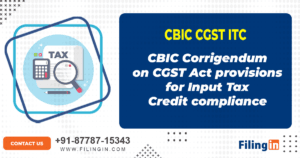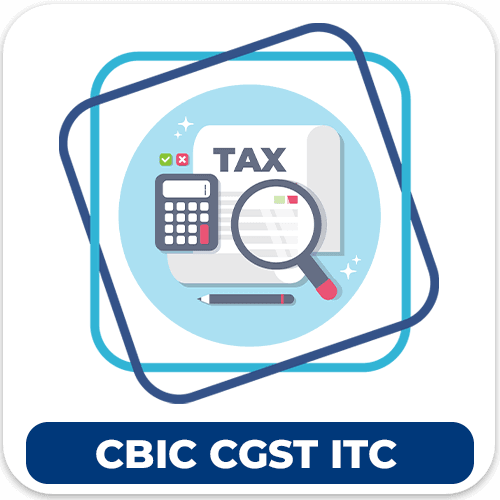The Central Board of Indirect Taxes and Customs (CBIC) recently released a corrigendum to Circular No. 237/31/2024-GST, further clarifying provisions under Section 16 of the Central Goods and Services Tax (CGST) Act, 2017. Dated October 25, 2024, this corrigendum addresses specific challenges related to Input Tax Credit (ITC), ensuring clarity for both taxpayers and GST officers on its eligibility criteria and application. Let’s delve into what these updates entail and how they impact taxpayers.

What Is Section 16 of the CGST Act, 2017?
Section 16 of the CGST Act is central to understanding the eligibility and conditions surrounding ITC. It allows registered taxpayers to claim credit for taxes paid on purchases used in taxable supplies. This corrigendum mainly focuses on sub-sections (5) and (6) of Section 16, which outline conditions and restrictions for claiming ITC.
The Latest Corrigendum: Key Highlights
1. Initial Release and Purpose
The corrigendum follows Circular No. 237/31/2024-GST, which was issued on October 15, 2024. The primary aim is to eliminate ambiguities in the original circular and clarify the practical application of provisions in Section 16.
2. Sub-section (5): ITC Restrictions for Personal Consumption
Sub-section (5) emphasizes restrictions on ITC claims for goods or services used partly for personal consumption. This clarification helps businesses better understand limitations when goods or services have dual usage.
3. Sub-section (6): ITC Reversals for Unreceived Goods
For goods not received within a specified timeframe, Sub-section (6) mandates ITC reversals. This corrigendum provides further guidance on calculating these reversals and meeting compliance deadlines.
A Closer Look at the Provisions
4. Time Limits for ITC Claims in Sub-section (4)
According to Sub-section (4), taxpayers must claim ITC by the thirtieth day of November following the financial year of the relevant invoice or by the date of the annual return, whichever is earlier. This time restriction is crucial for maintaining compliance under the CGST Act.
5. Recent Changes in Sub-section (5) and (6)
Provisions in Sub-section (5) and (6) were retrospectively applied to past financial years, specifically from 2017-2021, allowing registered persons more flexibility for ITC claims under these conditions.
6. Special Cases for ITC Claims Post Registration Cancellation
Sub-section (6) grants ITC eligibility to persons whose registration was previously canceled but later reinstated. This ensures that businesses don’t lose ITC benefits due to administrative issues.
New Guidelines on Refunds and ITC Reversals
7. Section 150 of Finance (No. 2) Act, 2024
This section specifies that no refund of reversed ITC will be granted due to retrospective amendments. This guideline safeguards the GST mechanism by preventing unwarranted refunds.
8. Relief for Pre-deposit Refunds in Appeals
Under the corrigendum, it is clarified that Section 150’s restriction does not apply to pre-deposit refunds made during appeals if the ruling is in favor of the taxpayer.
Additional Updates: Notifications and Special Procedures
9. Notification No. 22/2024-Central Tax
The corrigendum introduces a streamlined procedure for rectifying orders under Section 148 of the CGST Act, addressing taxpayers who may have claimed ITC improperly based on past interpretations.
10. Scope of the Corrigendum’s Impact on ITC Compliance
The corrigendum has significant implications for businesses, especially those with complex ITC claims. By addressing past errors and clarifying new conditions, the corrigendum provides businesses with a clearer path to ITC compliance.
Understanding the Practical Implications
11. Simplified ITC Calculation
This corrigendum includes examples to illustrate ITC calculation for partial and delayed supplies, ensuring taxpayers can accurately claim eligible credits.
12. Importance of Timely ITC Claims for Compliance
Timely filing of ITC claims is critical, and the corrigendum reiterates deadlines to prevent businesses from facing penalties due to delayed submissions.
13. Circle Rate Application for Land Cost in GST
The corrigendum mentions that land costs may be evaluated based on circle rates or a set ratio, whichever is higher. This impacts how GST is applied on construction projects, especially in real estate.
The corrigendum from CBIC provides comprehensive clarity on complex provisions under Section 16 of the CGST Act, 2017. With clear directives on ITC claims, reversals, and refund limitations, the corrigendum ensures that taxpayers and GST officers can operate with a clear understanding of their obligations. By addressing practical challenges and ambiguities, this update supports a smoother and more efficient GST compliance process for all involved.

